I am wondering why my Cypher query is taking an exorbitant amount of time.
Basically, I have a small family tree (two families), and I'm trying to add to each one a new node that carries some small bit of metadata so that the families are easier to keep isolated from each other when they are queried. (Thanks to @Tim Kuehn for this advice).
Once I run the query to populate my two families, I have this, which is built quickly with no problems:
Next, I want to create the aforementioned new nodes. The first node is created quickly, applied to the smaller family (I call them family B):
// 'add a :Family node for each relational group, like so:'
CREATE (famB:Family)
WITH famB
MATCH (a:Person {name:"Gramps Johnson"})-[:RELATED_TO*]->(b:Person)
MERGE (famB:Family)<-[:FAMILY]-(a)
MERGE (famB:Family)<-[:FAMILY]-(b)
...which gives me this. So far so good!
Moving forward, however, the slightly larger family's node is never created for some reason. The code is the same, but the query just runs and runs...
// 'add a :Family node for each relational group, like so:'
CREATE (famA:Family)
WITH famA
MATCH (a:Person {name:"Gramps Doe"})-[:RELATED_TO*]->(b:Person)
MERGE (famA:Family)<-[:FAMILY]-(a)
MERGE (famA:Family)<-[:FAMILY]-(b)
Why would this happen?
My first idea was to put an index on the name property:
// put index' on the name properties of the nodes:
// CREATE INDEX ON :Person(name)
but that didn't do anything.
So I tried to look at the EXPLAIN but it didn't really tell me anything. (It also runs forever on the terminal itself when executed.)
Thanks for your help.
Here's my code to create the graph:
// FAMILY A2: create grandparents, their son.
CREATE (grampsdoe:Person {name: 'Gramps Doe', id:'1', Gender:'Male', Diagnosis: 'Alzheimers', `Is Alive?`: 'No', Handedness: 'Left', `Risk Score`: 'PURPLE'})
CREATE (gramsdoe:Person {name: 'Grams Doe', id:'2', Gender:'Female', Diagnosis: 'Alzheimers', `Is Alive?`: 'No', Handedness: 'Right', `Risk Score`: 'GIRAFFE'})
CREATE (daddoe:Person {name: 'Dad Doe', id:'3', Gender:'Male', Diagnosis: 'MCI', `Is Alive?`: 'No', Handedness: 'Right', `Risk Score`: 'GIRAFFE'})
CREATE
(grampsdoe)-[:RELATED_TO {relationship: 'Husband'}]->(gramsdoe),
(gramsdoe)-[:RELATED_TO {relationship: 'Wife'}]->(grampsdoe),
(grampsdoe)-[:RELATED_TO {relationship: 'Father'}]->(daddoe),
(gramsdoe)-[:RELATED_TO {relationship: 'Mother'}]->(daddoe),
(daddoe)-[:RELATED_TO {relationship: 'Son'}]->(grampsdoe),
(daddoe)-[:RELATED_TO {relationship: 'Son'}]->(gramsdoe)
// FAMILY A2: create grandparents, their daughter
CREATE (grampssmith:Person {name: 'Gramps Smith', id:'4', Gender:'Male', Diagnosis: 'Normal', `Is Alive?`: 'No', Handedness: 'Left', `Risk Score`: 'PURPLE'})
CREATE (gramssmith:Person {name: 'Grams Smith', id:'5', Gender:'Female', Diagnosis: 'Alzheimers', `Is Alive?`: 'No', Handedness: 'Ambidextrous', `Risk Score`: 'PURPLE'})
CREATE (momsmith:Person {name: 'Mom Doe', id:'6', Gender:'Female', Diagnosis: 'Alzheimers', `Is Alive?`: 'No', Handedness: 'Right', `Risk Score`: 'GIRAFFE'})
CREATE
(grampssmith)-[:RELATED_TO {relationship: 'Husband'}]->(gramssmith),
(gramssmith)-[:RELATED_TO {relationship: 'Wife'}]->(grampssmith),
(grampssmith)-[:RELATED_TO {relationship: 'Father'}]->(momsmith),
(gramssmith)-[:RELATED_TO {relationship: 'Mother'}]->(momsmith),
(momsmith)-[:RELATED_TO {relationship: 'Daughter'}]->(grampssmith),
(momsmith)-[:RELATED_TO {relationship: 'Daughter'}]->(gramssmith)
// FAMILY A3: 'Dad Doe' and 'Mom Smith' get married and have 2 kids who are twins
CREATE (lilbro:Person {name: 'Lil Bro', id:'7', Gender:'Male', Diagnosis: 'Normal', `Is Alive?`: 'Yes', Handedness: 'Right', `Risk Score`: 'PURPLE'})
CREATE (bigsis:Person {name: 'Big Sis', id:'8', Gender:'Female', Diagnosis: 'Normal', `Is Alive?`: 'Yes', Handedness: 'Right', `Risk Score`: 'PURPLE'})
CREATE (daddoe)-[:RELATED_TO {relationship: 'Husband'}]->(momsmith)
CREATE (momsmith)-[:RELATED_TO {relationship: 'Wife'}]->(daddoe)
CREATE (lilbro)-[:RELATED_TO {relationship: 'Brother'}]->(bigsis)
CREATE
(lilbro)-[:RELATED_TO {relationship: 'Grandson'}]->(grampsdoe),
(grampsdoe)-[:RELATED_TO {relationship: 'Grandfather'}]->(lilbro),
(lilbro)-[:RELATED_TO {relationship: 'Grandson'}]->(grampssmith),
(grampssmith)-[:RELATED_TO {relationship: 'Grandfather'}]->(lilbro),
(lilbro)-[:RELATED_TO {relationship: 'Grandson'}]->(grampssmith),
(grampssmith)-[:RELATED_TO {relationship: 'Grandmother'}]->(lilbro),
(lilbro)-[:RELATED_TO {relationship: 'Grandson'}]->(gramssmith),
(gramssmith)-[:RELATED_TO {relationship: 'Grandmother'}]->(lilbro),
(lilbro)-[:RELATED_TO {relationship: 'Son'}]->(daddoe),
(daddoe)-[:RELATED_TO {relationship: 'Father'}]->(lilbro),
(lilbro)-[:RELATED_TO {relationship: 'Son'}]->(momsmith),
(momsmith)-[:RELATED_TO {relationship: 'Mother'}]->(lilbro),
(bigsis)-[:RELATED_TO {relationship: 'Sister'}]->(lilbro),
(bigsis)-[:RELATED_TO {relationship: 'Granddaughter'}]->(grampsdoe),
(grampsdoe)-[:RELATED_TO {relationship: 'Grandfather'}]->(bigsis),
(bigsis)-[:RELATED_TO {relationship: 'Granddaughter'}]->(grampssmith),
(grampssmith)-[:RELATED_TO {relationship: 'Grandfather'}]->(bigsis),
(bigsis)-[:RELATED_TO {relationship: 'Granddaughter'}]->(gramsdoe),
(gramsdoe)-[:RELATED_TO {relationship: 'Grandmother'}]->(bigsis),
(bigsis)-[:RELATED_TO {relationship: 'Granddaughter'}]->(gramssmith),
(gramssmith)-[:RELATED_TO {relationship: 'Grandfather'}]->(bigsis),
(bigsis)-[:RELATED_TO {relationship: 'Daughter'}]->(daddoe),
(daddoe)-[:RELATED_TO {relationship: 'Father'}]->(bigsis),
(bigsis)-[:RELATED_TO {relationship: 'Daughter'}]->(momsmith),
(momsmith)-[:RELATED_TO {relationship: 'Mother'}]->(bigsis)
// FAMILY B1: create grandparents, their son.
CREATE (grampsjohnson:Person {name: 'Gramps Johnson', id:'9', Gender:'Male', Diagnosis: 'Normal', `Is Alive?`: 'No', Handedness: 'Right', `Risk Score`: 'GIRAFFE'})
CREATE (gramsjohnson:Person {name: 'Grams Johnson', id:'10', Gender:'Female', Diagnosis: 'Normal', `Is Alive?`: 'No', Handedness: 'Right', `Risk Score`: 'GIRAFFE'})
CREATE (johnjohnson:Person {name: 'John Johnson', id:'11', Gender:'Male', Diagnosis: 'MCI', `Is Alive?`: 'Yes', Handedness: 'Right', `Risk Score`: 'GIRAFFE'})
CREATE
(grampsjohnson)-[:RELATED_TO {relationship: 'Husband'}]->(gramsjohnson),
(gramsjohnson)-[:RELATED_TO {relationship: 'Wife'}]->(grampsjohnson),
(grampsjohnson)-[:RELATED_TO {relationship: 'Father'}]->(johnjohnson),
(gramsjohnson)-[:RELATED_TO {relationship: 'Mother'}]->(johnjohnson),
(johnjohnson)-[:RELATED_TO {relationship: 'Son'}]->(grampsjohnson),
(johnjohnson)-[:RELATED_TO {relationship: 'Son'}]->(gramsjohnson)



